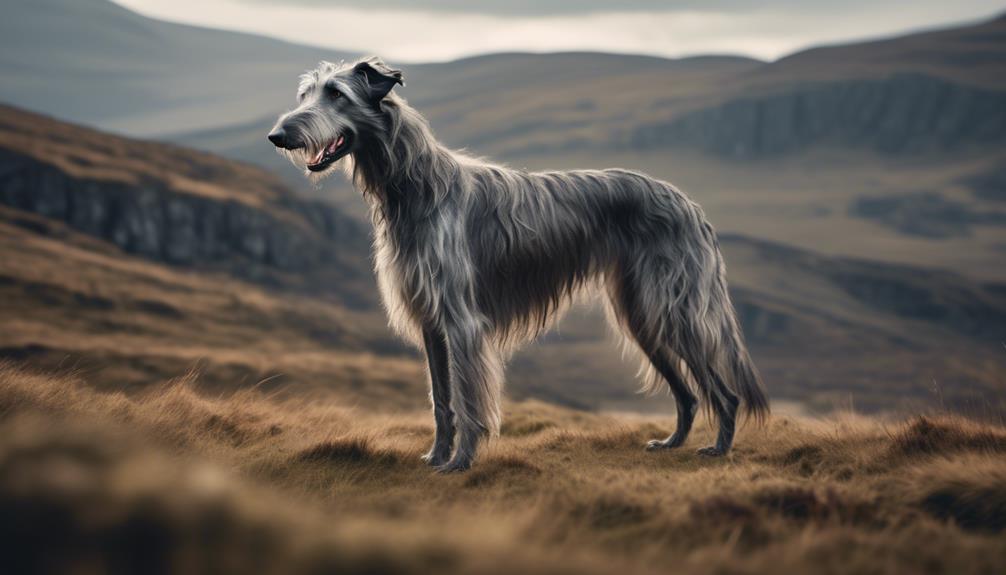
Looking for a dog breed that embodies both grace and strength? You might be thinking, ‘But aren’t large dogs too difficult to handle?’
While it’s true that some big breeds can be a handful, the Scottish Deerhound is different. This majestic breed not only possesses immense hunting abilities, but they also have a gentle and affectionate nature towards humans.
Curious to learn more about the Scottish Deerhound’s unique characteristics? Well, let’s just say there’s a lot more than meets the eye.
Key Takeaways
- Scottish Deerhounds were originally bred for hunting Scottish roe deer and are designed to take on prey twice their size.
- They are known for their speed, agility, and excellent hunting abilities.
- Scottish Deerhounds require ample space to run and exercise, making them unsuitable for apartment living.
- They need an experienced trainer who can provide firm and consistent training, as well as plenty of mental and physical stimulation.
Purpose of Scottish Deerhound
The purpose of the Scottish Deerhound is to hunt and bring down the Scottish roe deer, utilizing its specialized hunting abilities. Originally bred for this specific task, the Scottish Deerhound is designed to take on prey twice or more their size. Their hunting abilities were developed over time, making them known for their exceptional speed and agility.
These dogs excel in chasing and capturing game, making them highly efficient hunters. However, their hunting instincts also make them unsuitable for apartment living. Scottish Deerhounds require ample space to run and exercise, as well as an experienced trainer to handle their strong-willed nature.
Additionally, they dislike being left alone for long periods, craving human companionship. With proper training and socialization, Scottish Deerhounds can become affectionate and obedient companions.
See another Dog breed profile.
Scottish Terrier Dog Breed
Characteristics of Scottish Deerhound
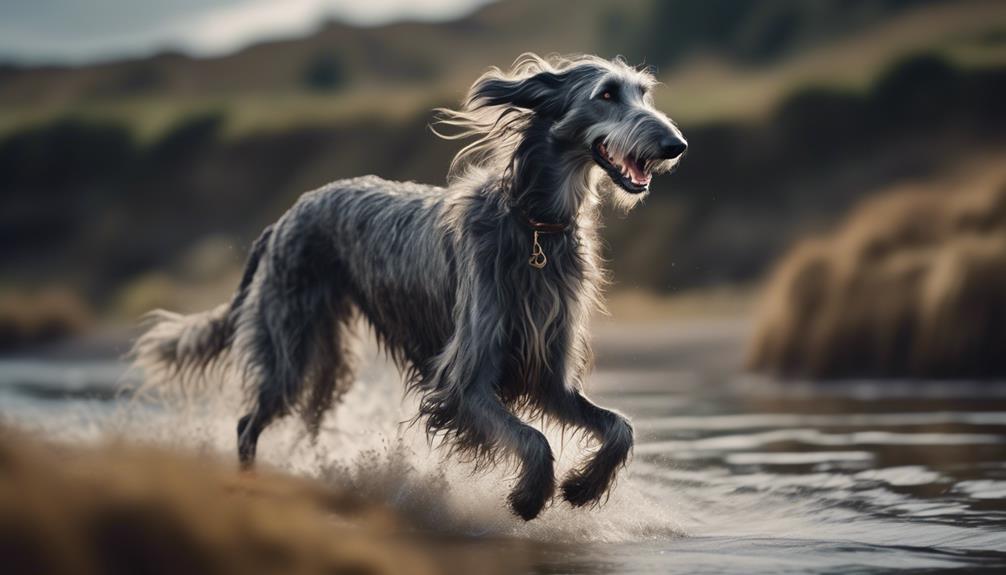
Now let’s take a closer look at the Scottish Deerhound’s distinguishing characteristics:
- Majestic Appearance: With their tall and lean build, the Scottish Deerhound exudes elegance and grace. Their long, wiry coat adds to their regal charm, while their expressive eyes and gently arched brows give them a wise and noble look.
- Impressive Size: Standing at around 30 to 32 inches at the shoulder, the Scottish Deerhound is one of the tallest dog breeds. Their size enables them to take on formidable prey, showcasing their strength and bravery.
- Gentle and Loving Nature: Despite their impressive hunting abilities, Scottish Deerhounds are known for their gentle and affectionate demeanor. They form strong bonds with their human families and thrive on companionship. Their calm and patient nature makes them excellent family pets, although they may not do well in apartments due to their need for ample space to run and exercise.
Exercise Needs of Scottish Deerhound
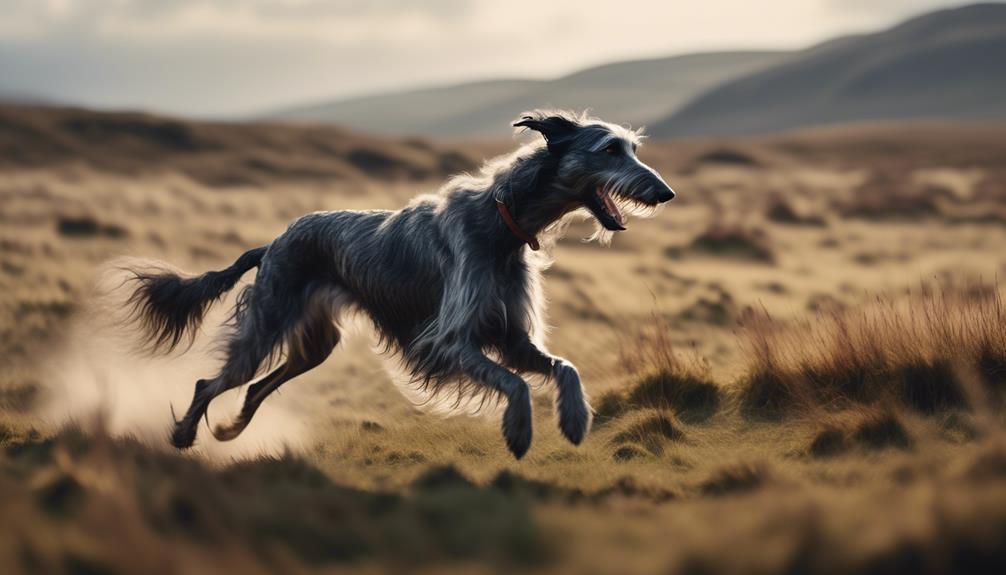
To meet the exercise needs of a Scottish Deerhound, it is important to provide regular opportunities for physical activity and mental stimulation. Scottish Deerhounds have high energy levels and thrive with opportunities to run freely. They require regular long walks to keep them physically fit. In addition to walks, they benefit from activities like lure coursing or agility training to challenge their minds and keep them engaged. It is crucial to provide a large, securely fenced yard where they can run and play. Below is a table summarizing the exercise needs of a Scottish Deerhound:
| Exercise Needs of Scottish Deerhound |
|---|
| Regular long walks |
| Opportunities to run freely |
| Mental stimulation |
Training Needs of Scottish Deerhound
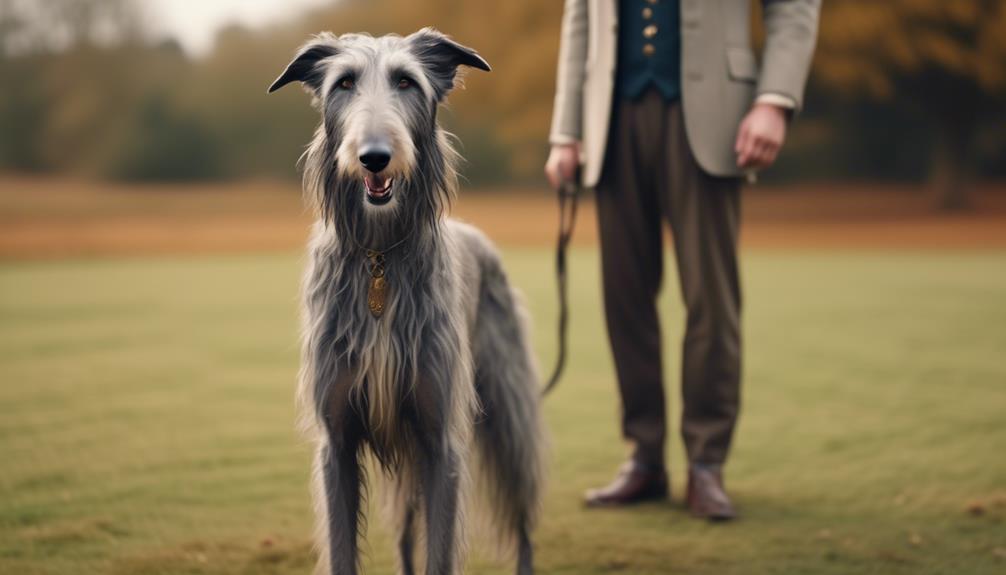
To effectively meet the exercise needs of a Scottish Deerhound, it’s essential to also address their training requirements. These gentle giants thrive with opportunities to run freely and have high energy levels. To keep them mentally and physically stimulated, activities like lure coursing or agility training are beneficial.
Scottish Deerhounds need a firm and consistent trainer who can provide early socialization and respond well to positive reinforcement techniques. While they’re affectionate towards humans, they aren’t suitable for apartment living and require ample space to run and exercise.
These intelligent dogs can be stubborn at times, but they excel in obedience and agility training. It’s important to note that Scottish Deerhounds dislike being left alone for long periods, so providing them with companionship and attention is crucial to their well-being.
Living Conditions for Scottish Deerhound
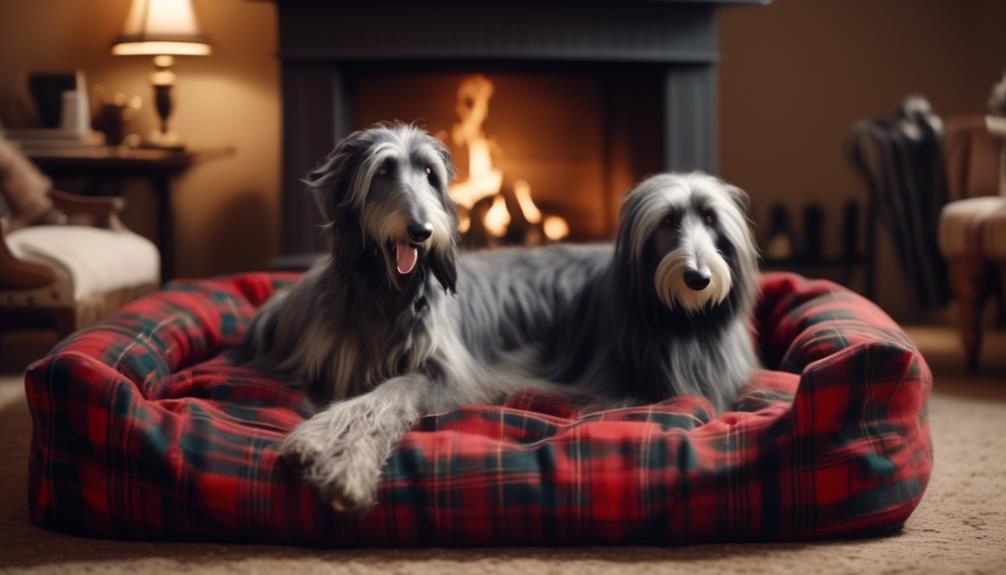
Scottish Deerhounds thrive in homes with a large, securely fenced yard where they can roam and exercise freely. They are not suitable for apartment living and require ample space to run and exercise. Additionally, they may not get along well with small animals, so it’s important to provide a controlled environment for them. Scottish Deerhounds also need a comfortable and cozy spot to rest, and they enjoy having a designated space on a sofa or bed for napping. To summarize, here is a table highlighting the living conditions for Scottish Deerhounds:
| Living Conditions for Scottish Deerhound |
|---|
| Large, securely fenced yard |
| Not suitable for apartment living |
| Controlled environment for small animals |
| Comfortable and cozy resting spot |
| Designated space for napping |
Hunting Abilities of Scottish Deerhound
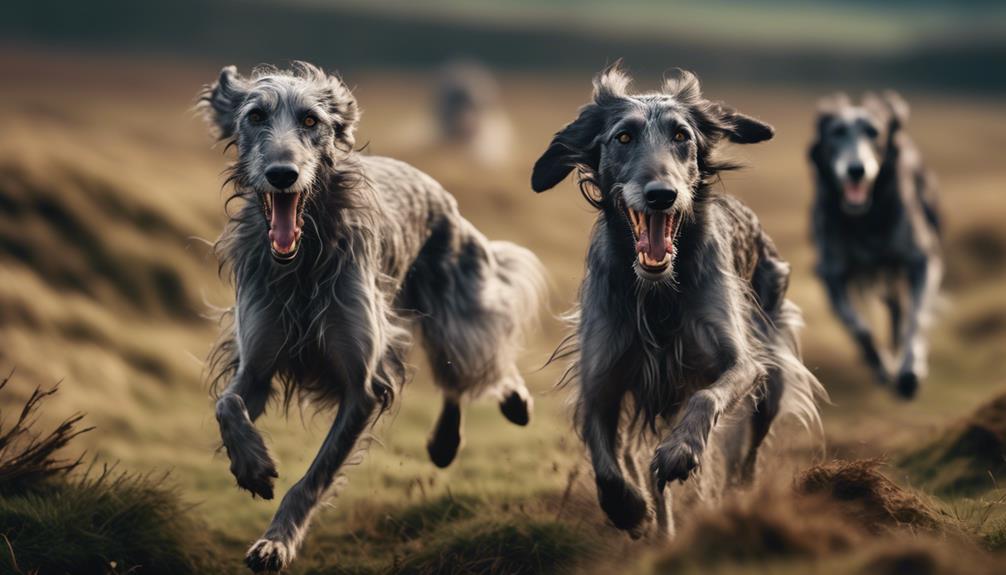
With their impressive speed and agility, Scottish Deerhounds are highly skilled hunters, capable of taking down prey that’s twice or more their size. Their hunting abilities are a testament to their breed’s purpose and development. Here are three characteristics that make them exceptional hunters:
- Swift and Graceful: Scottish Deerhounds possess a natural grace and elegance in their movements, allowing them to swiftly navigate various terrains while chasing their prey. Their long legs and slender bodies enable them to cover ground quickly and effortlessly.
- Powerful Bite: Despite their gentle demeanor, Scottish Deerhounds have a strong and powerful bite, which they use to bring down large prey. Their jaws have the strength to immobilize and subdue formidable opponents.
- Excellent Stamina: These dogs have remarkable endurance, enabling them to pursue prey over long distances. Their muscular bodies and efficient breathing help them maintain their speed and agility for extended periods, making them formidable hunters in the wild.
Affectionate Nature of Scottish Deerhound
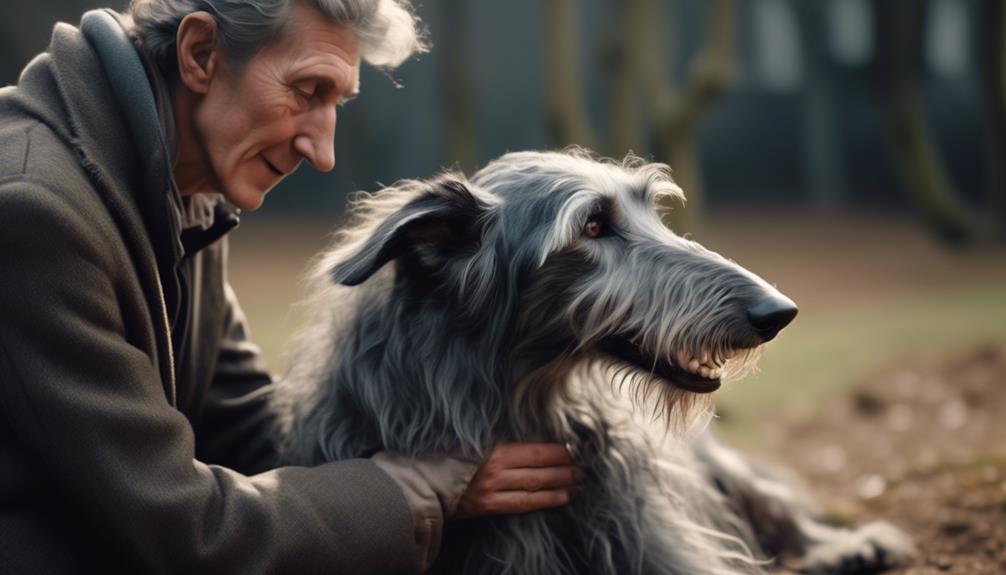
Their exceptional hunting abilities are complemented by the Scottish Deerhound’s affectionate nature towards humans. Despite their large size and hunting background, Scottish Deerhounds are known to be gentle and loving companions. They form strong bonds with their human family members and thrive on human affection and attention. Scottish Deerhounds are often described as being “gentle giants” due to their kind and affectionate temperament. They enjoy being close to their owners and are known to be loyal and devoted. However, it is important to note that Scottish Deerhounds require ample space to run and exercise, and they are not suitable for apartment living. They also need an experienced trainer who can provide them with the guidance and structure they require.
| Affectionate Nature of Scottish Deerhound |
|---|
| 1. Gentle and loving companions |
| 2. Form strong bonds with their human family members |
| 3. Thrive on human affection and attention |
| 4. Described as “gentle giants” |
| 5. Loyal and devoted |
Challenges in Training Scottish Deerhound
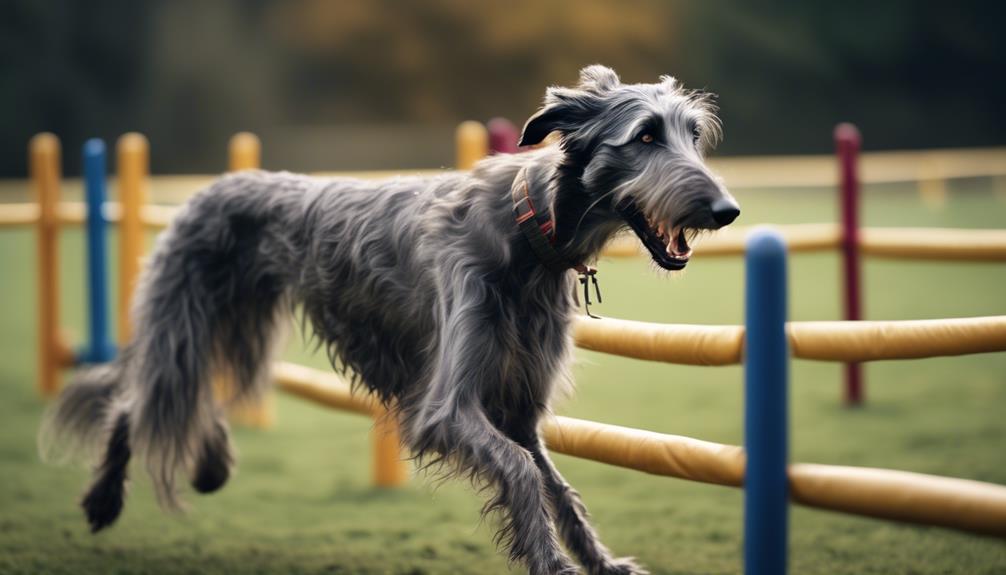
Training a Scottish Deerhound can present some challenges due to their independent nature and occasional stubbornness. Here are three challenges you may encounter when training a Scottish Deerhound:
- Strong-willed independence: Scottish Deerhounds have a strong sense of independence, which can make them less inclined to follow commands. They may prefer to do things their own way, which can make training sessions frustrating at times.
- Selective listening: Scottish Deerhounds may have a tendency to selectively listen to commands. They may choose to ignore certain commands or only respond when they feel like it. This can require extra patience and consistency during training sessions.
- Sensitivity to harsh training methods: Scottish Deerhounds are sensitive dogs and can become easily discouraged or disengaged by harsh training methods. It’s important to use positive reinforcement techniques, such as treats and praise, to motivate and reward them for good behavior.
Scottish Deerhound’s Suitability for Apartment Living
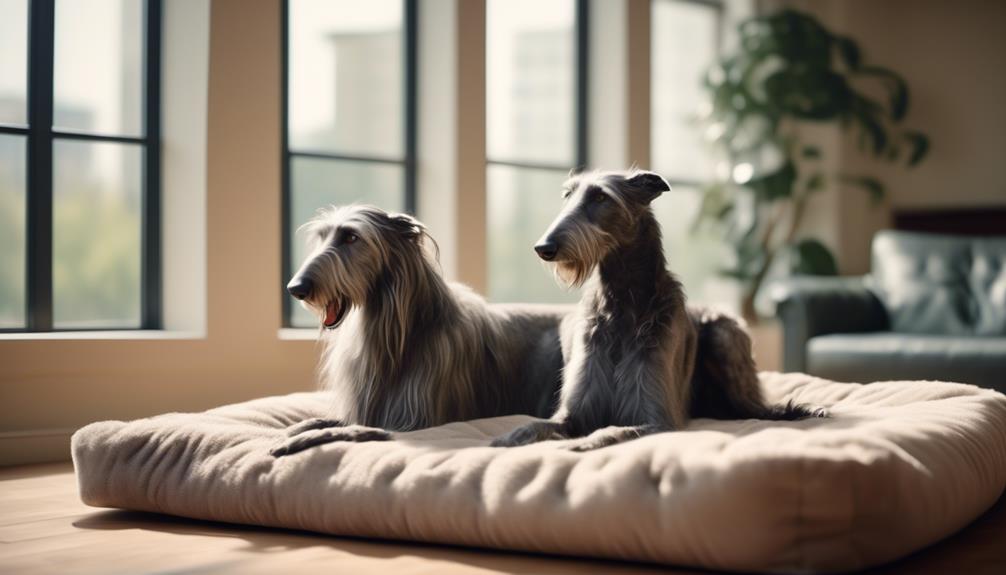
Living in an apartment may not be the most suitable environment for a Scottish Deerhound due to their need for ample space to run and exercise. Scottish Deerhounds are known for their speed and agility, and they require regular exercise to stay happy and healthy. They thrive with opportunities to run freely and have high energy levels.
Long walks alone may not be enough to fulfill their exercise needs, as they benefit from activities like lure coursing or agility training. These dogs also need a firm and consistent trainer, as they can be stubborn at times.
Additionally, Scottish Deerhounds dislike being left alone for long periods, so it’s important to consider their needs before choosing apartment living.
Socialization Needs of Scottish Deerhound
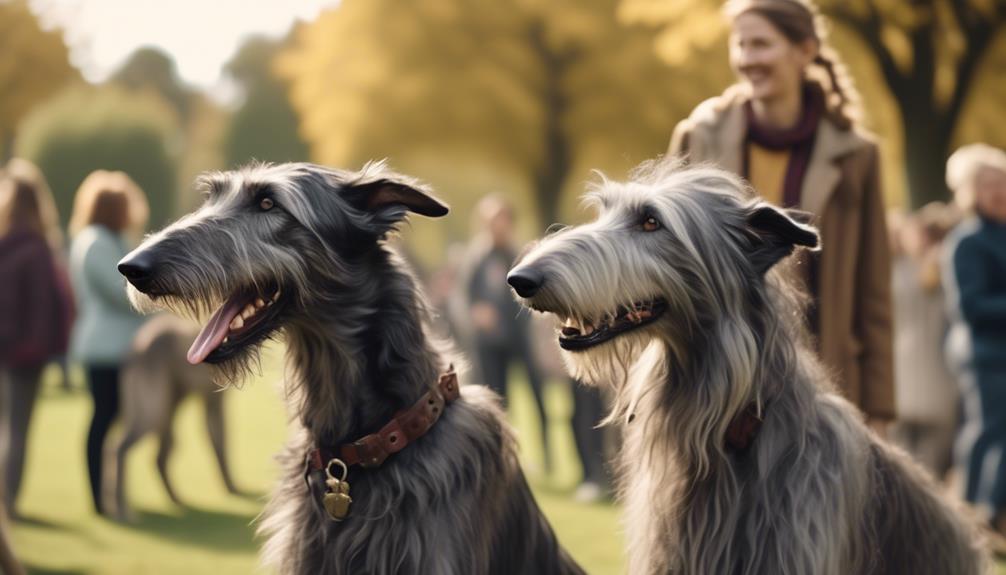
To ensure a well-rounded and sociable Scottish Deerhound, early socialization is crucial. Here are three important aspects to keep in mind when socializing your Scottish Deerhound:
- Introduce them to various people:
Expose your Scottish Deerhound to different individuals, including men, women, children, and strangers. This will help them become comfortable around people of all ages and backgrounds.
- Familiarize them with different environments:
Take your Scottish Deerhound to various places such as parks, beaches, and busy streets. Exposing them to different sights, sounds, and smells will help them adapt to new environments and reduce their chances of becoming fearful or anxious.
- Encourage positive interactions with other dogs:
Arrange playdates or visits to dog parks to allow your Scottish Deerhound to interact with other dogs. This will help them develop proper social skills and learn how to communicate and play with their canine counterparts.
Scottish Deerhound’s Compatibility With Small Animals
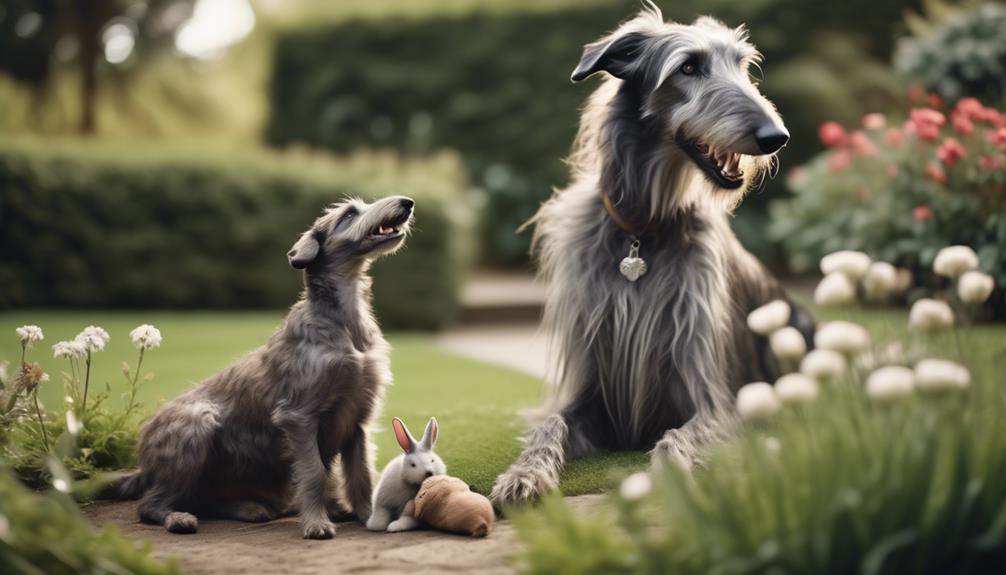
If you have small animals in your home, it’s important to consider the Scottish Deerhound’s compatibility with them. Due to their strong hunting instincts and history of being bred to chase down prey, Scottish Deerhounds may not be the best match for households with small animals such as rabbits, cats, or small dogs.
While they can be gentle and affectionate towards humans, their prey drive may be triggered when they encounter smaller animals. It’s crucial to supervise interactions between a Scottish Deerhound and small pets to ensure the safety of all animals involved.
Additionally, early socialization and training are essential to help manage their instinctual behaviors and reduce the risk of any potential conflicts.
Frequently Asked Questions
What Are Some Common Health Issues That Scottish Deerhounds May Experience?
Common health issues that Scottish Deerhounds may experience include bloat, heart disease, and bone cancer. Regular veterinary check-ups, a balanced diet, and exercise can help maintain their overall health and well-being.
Are Scottish Deerhounds Good With Children?
Scottish Deerhounds are good with children. They have an affectionate nature and enjoy being around humans. However, they require ample space to run and exercise, so make sure you have a large, fenced yard.
Do Scottish Deerhounds Shed a Lot?
Yes, Scottish Deerhounds do shed a moderate amount. Regular grooming can help minimize shedding, but they still require brushing to remove loose hair.
Are Scottish Deerhounds Good Guard Dogs?
No, Scottish Deerhounds are not typically good guard dogs. They are more affectionate and friendly towards humans than protective. Their focus is on hunting and chasing game, rather than guarding property.
Can Scottish Deerhounds Be Trained to Be Off-Leash?
Yes, Scottish Deerhounds can be trained to be off-leash, but it requires consistent training, early socialization, and a securely fenced area. With the right approach and effort, they can learn to roam freely under supervision.
Conclusion
In conclusion, the Scottish Deerhound is a majestic and agile dog that excels in hunting and capturing game. They require ample space to run and exercise, making them unsuitable for apartment living.
With their affectionate nature towards humans, they make great companions. However, they need a dedicated and experienced trainer due to their stubbornness.
Overall, if you’re looking for a skilled hunter and a loving companion, the Scottish Deerhound may be the perfect addition to your family.




